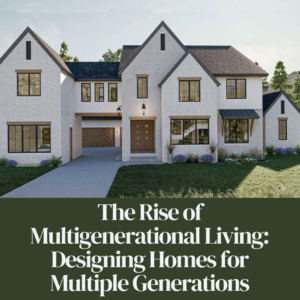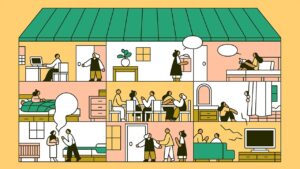
Multigenerational living, where multiple generations of a family live together under one roof, is becoming increasingly popular. This trend is driven by various factors, including economic pressures, cultural traditions, and a desire for closer family bonds. As more families embrace this living arrangement, there is a growing need for homes designed to accommodate the needs of multiple generations. In this blog post, we’ll explore the rise of multigenerational living and discuss some key design considerations for creating homes that cater to the needs of diverse family members.
Flexible Floor Plans:
One of the key design considerations for multigenerational homes is a flexible floor plan that can adapt to changing family dynamics. This includes creating separate living spaces for different generations, such as a self-contained suite for elderly parents or adult children. Additionally, flexible spaces that can serve multiple purposes, such as a home office that can double as a guest room, are essential for accommodating the diverse needs of multigenerational families.

Accessibility Features:
Another important consideration for multigenerational homes is accessibility. This includes features such as ramps, wider doorways, and grab bars in bathrooms to accommodate elderly family members or those with mobility issues. Designing a home that is accessible to all generations ensures that everyone can move around comfortably and safely.
Privacy and Shared Spaces:
While multigenerational living promotes closer family bonds, it’s also essential to provide privacy for each generation. Designing separate living areas with private bedrooms and bathrooms allows family members to have their space while still living together. At the same time, incorporating shared spaces such as a communal kitchen, dining area, or family room encourages interaction and bonding among family members.

Multifunctional Design:
Multifunctional design is key to maximizing space in multigenerational homes. This includes incorporating furniture and storage solutions that serve multiple purposes, such as a sofa bed or built-in shelving. Additionally, flexible rooms that can be easily transformed from a playroom to a home office or guest room allow for efficient use of space and cater to the changing needs of the family.
Outdoor Living Spaces:
Outdoor living spaces are an essential feature of multigenerational homes, providing additional space for relaxation and recreation. Designing a backyard or patio area with seating, a barbecue area, and maybe even a garden allows family members of all ages to enjoy the outdoors together.

As multigenerational living becomes more common, designing homes that cater to the needs of diverse family members is essential. By incorporating flexible floor plans, accessibility features, privacy considerations, multifunctional design, and outdoor living spaces, homeowners can create homes that accommodate multiple generations while promoting closer family bonds. Whether you’re planning to accommodate elderly parents, adult children, or other family members, designing a multigenerational home that meets everyone’s needs is key to creating a harmonious and comfortable living environment for all.
Please share this article and follow us for more tips!

